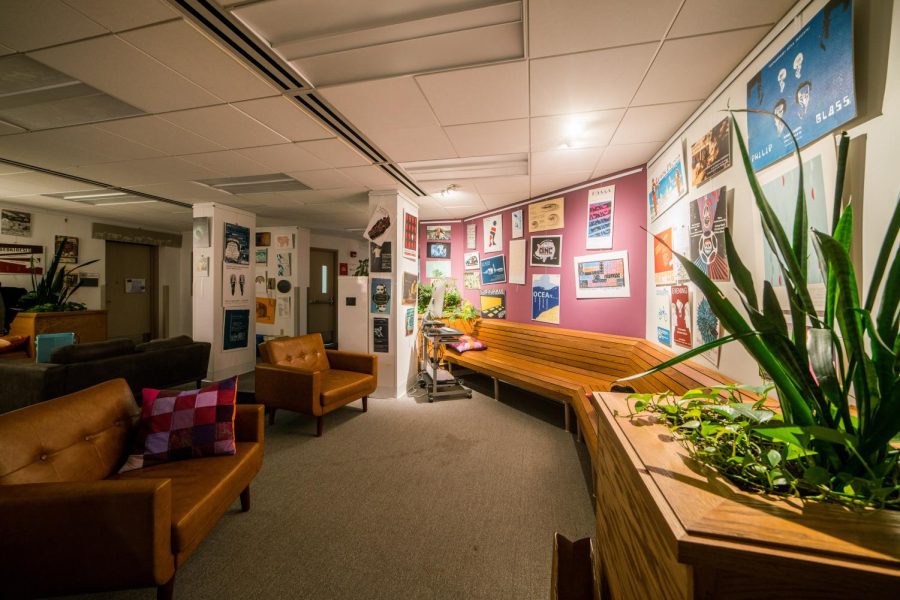Student Life Thrives in Basements Around Campus
Photos by Erin Koo and Abe Frato, Photo Editors
The Timara Department’s underground office.
With recent renovations of Severance Hall and Wilder Hall, class meeting spaces have been reassigned to unconventional locations. Many of Oberlin’s major creative hubs operate underground, out of basements dispersed throughout campus. The Office of Spirituality and Dialogue was one such body subject to relocation. According to Barefoot Dialogue Fellow Shogo Ishikawa, the OSD’s new location in the basement of Bosworth Hall, the building that houses Fairchild Chapel, bears extra significance.
“[It] holds meaning as an office that supports religious communities around campus and promotes religious and non-religious pluralism,” Ishikawa said. “It is true that me and my colleagues were feeling isolated and were worried that the challenges that the space offers could separate our office from the student body and the Oberlin community at large,” Ishikawa continued. However, the “events that we hold [every] month proved that students, faculty and staff members, and even alums are able to connect with each other in the basement of an underrepresented building.”
Still, Ishikawa expressed concern about “the physical inaccessibility of the Bosworth basement as an office that advocates for disability rights.”
Recent moves like that of the OSD encourage us to rethink how our physical environment shapes our learning and living experiences. Home to the Rathskeller, DeCafé, the mailroom, and Dionysus Disco, the basement of Wilder Hall is the heart of campus. These establishments’ location in the basement of Wilder seems like a practical choice, given the building’s origins as a residence hall. However, the reasons for other organizations being confined to the Oberlin underground are
harder to imagine.
The office of The Oberlin Review is located in the basement of Burton Hall. The space resembles more of an enclosed hallway rather than a single room, and is forced to contend with pervasive humidity wafting from the adjacent Burton laundry room. The other end of Burton’s basement houses The Grape, Oberlin’s alternative student news and culture magazine that has been in publication since 1999. The office of The Grape is located directly next to practice rooms where, during most hours of the day and continuing into the night, students can be heard practicing the same portion of a song over and over. While the subterranean nature of these spaces inevitably creates subpar conditions, it is clear that a home and a history has been formed within them. The walls of the Review’s office are plastered with photos and words from past and present generations of Review staff, and couches line the narrow conjoined rooms. In The Grape’s office, plants are placed where they can reach the small amount of light from the egress windows.
College second-year Jules Crosetto, layout editor for The Grape, is confidently “pro-basement office.”
Crosetto explains that the magazine’s staff had been working out of Mudd Center during the COVID-19 pandemic, before learning that the previous staff’s office had been sitting unoccupied in a basement. After months spent as nomadic creatives operating in a public study space, The Grape was provided with a room that was uniquely theirs.
The TIMARA department has remained an integral part of the Conservatory since its establishment in 1973, and TIMARA’s studios are currently located in the basement of Bibbins Hall. TIMARA students benefit from the isolation provided by their cozy basement department. Their experiments with sound are often noisy and the basement studios must be properly soundproofed. The space serves as storage for extensive gear, from the synthesizers in the Analog Synth Studio to recording equipment, and as a venue for the TIMARA gallery in which students showcase their interdisciplinary projects. The TIMARA official website includes a subway-style blueprint map of the department, poking fun at their underground location.
Savino Go, a double-degree first-year in TIMARA, sees the basement location as “pretty central to the TIMARA identity,” noting that the TIMARA basement provides a stark contrast in design to the conservatory above it.
“It’s my understanding that in recent years, the composition department in the Con have taken an increasingly traditionalist approach to their music education, and have distanced themselves from the TIMARA department in doing so,” Go said.
These converted basements may feel claustrophobic to outsiders, but students and faculty using such unconventional spaces seem to view the constraints presented by their environments as vehicles for building community. In going underground, the outside world is shut out, and creativity, safety, and security remain.










